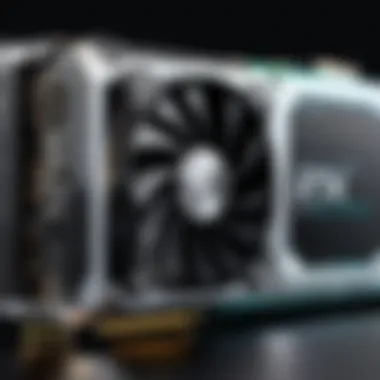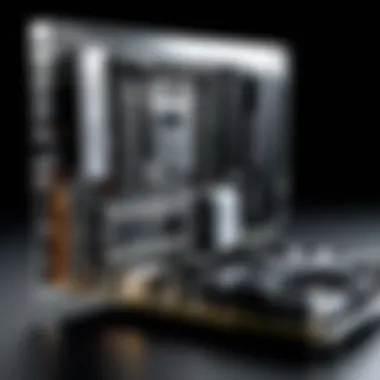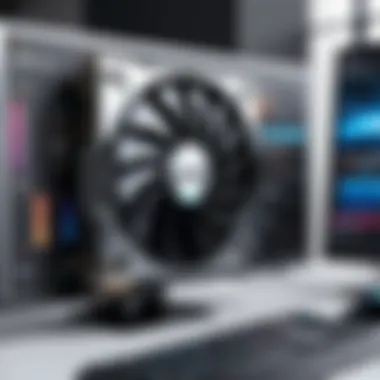GFORCE RTX 2080 Review: Performance Insights & Impact


Intro
The GFORCE RTX 2080 has emerged as a cornerstone in the landscape of graphics cards since its launch. Its architecture, built on NVIDIA's Turing GPU, supports advanced features such as real-time ray tracing and AI-enhanced graphics, significantly elevating the gaming and professional experience. This section will explore the performance capabilities of the RTX 2080, alongside its architectural design and how it fits into the market among competitors.
As we delve into key performance metrics, user experience, and the implications of its technology, a thorough understanding will emerge about the RTX 2080 and what it offers to both gamers and professionals. This review aims to provide the necessary insights for informed purchasing decisions, considering the evolving nature of technology in the graphics card domain.
Performance Metrics
The RTX 2080 stands out in performance owing to its cutting-edge technology and architecture. Understanding its capabilities requires a detailed look into specific performance metrics.
Benchmarking results
Benchmark tests reveal that the GFORCE RTX 2080 performs exceptionally well across various gaming titles. In games like "Battlefield V" and "Shadow of the Tomb Raider," the RTX 2080 can produce frame rates exceeding 60 FPS at ultra settings. This makes it a strong contender for high-end gaming setups.
Listed below are notable benchmarking results:
- 3DMark Fire Strike: 20,000+ score, highlighting its excellent synthetic performance.
- Ultra 4K Gaming: Maintains playability with frame rates averaging around 40-50 FPS in AAA titles.
These figures indicate that the RTX 2080 is equipped to handle demanding workloads effectively, showcasing its prowess in both gaming and professional applications.
Speed and responsiveness
The responsiveness of the RTX 2080 is particularly noteworthy when it comes to rendering and processing tasks. With NVIDIA's G-SYNC technology, the graphics card minimizes latency, ensuring smoother gameplay. Users experience minimal input lag, which enhances the overall gaming experience.
In professional contexts, such as video editing or graphic design, the RTX 2080 excels in tasks requiring rapid visual rendering. With CUDA cores optimized for parallel processing, software such as Adobe Premiere Pro and Blender can take full advantage of the GPU's capabilities, leading to faster rendering times and improved productivity.
Usability and User Experience
Despite the exceptional performance specs, user experience plays an equally critical role in adopting the RTX 2080. Evaluating this aspect involves assessing installation ease and interface design.
Ease of installation and setup
Installing the RTX 2080 is relatively straightforward. The card adheres to the standard PCI Express interface, which most modern motherboards support. Users just need to insert it into the motherboard, connect the necessary power cables, and install the appropriate drivers. Detailed guides are available on platforms like reddit.com for users seeking assistance.
Interface design and navigation
On the software side, the NVIDIA Control Panel allows users to fine-tune performance settings effortlessly. The interface is user-friendly, providing options for adjusting resolution, display settings, and managing multiple displays. Users can customize settings based on their unique preferences, ensuring optimal performance tailored to their specific needs.
Overall, the GFORCE RTX 2080 offers an appealing blend of usability and robust performance metrics, making it a pivotal option for both gaming and professional scenarios. Its impact on user experience enhances its value in a rapidly advancing technological landscape.
Prelude to GFORCE RTX
The GFORCE RTX 2080 represents a significant leap in the world of graphics processing units. Its introduction marked a pivotal moment for gamers and professionals alike, showcasing advanced capabilities previously unseen in consumer-grade hardware. This article delves into the nuances of the RTX 2080, offering insights into what makes it a vital component in modern computing environments.
Overview of Graphics Processing Units
Graphics Processing Units, or GPUs, are integral to rendering images and performing complex calculations in modern computers. Unlike traditional CPUs, which manage general tasks, GPUs excel in executing parallel operations. This makes them essential for applications that require extensive graphical rendering, such as video games, simulations, and professional design software.
The GFORCE RTX 2080 stands out due to its enhanced processing power and advanced features, which facilitate real-time ray tracing and AI-driven graphics improvements. The technical specifications reveal a robust architecture enabling more realistic visual effects in gaming and demanding applications.
In summary, understanding GPU functionality is crucial for appreciating the advancements found in the RTX 2080. It influences buyer decisions and informs potential uses across various sectors.
The Evolution of NVIDIA's Graphics Cards


NVIDIA has consistently been at the forefront of graphics technology, evolving its product line to meet increasing consumer demands. The transition from older models to the RTX series represents not just an incremental upgrade but a fundamental shift in how graphics are processed. Each generation brings improvements in speed, efficiency, and capability.
The RTX 2080 is a culmination of years of development, integrating features like real-time ray tracing and AI-enhanced rendering. These advancements not only improve gaming experiences but also elevate productivity in professional settings.
Historically, NVIDIA's trajectory has set new standards for graphics performance, with each card often seen as a benchmark. The RTX 2080 continues this legacy, providing exceptional performance that reiterates NVIDIA's commitment to innovation in the graphics domain.
Architectural Features of RTX
The architectural features of the GFORCE RTX 2080 are pivotal in understanding its performance and capabilities. A blend of advanced engineering and forward-thinking technology allows this graphics card to stand out in a crowded market. The focus on CUDA Cores, Tensor Cores, and ray tracing technology plays an important role in shaping the gaming and professional experience. Each of these components offers distinct benefits and addresses particular needs of users, making the RTX 2080 a compelling choice for both gamers and professionals.
CUDA Cores and Their Importance
CUDA cores are fundamental units within the RTX 2080 that perform parallel computations. By handling multiple threads simultaneously, they boost overall performance in gaming and professional applications. The increase in CUDA core count compared to earlier models allows for more simultaneous computations. For developers, this means improved performance for applications that rely heavily on computation, such as 3D rendering software and video editing tools.
- Increased Processing Power: More CUDA cores directly enhance the computation capabilities of the graphics card.
- Enhanced Frame Rates: Video games benefit from CUDA cores, resulting in smoother graphics and improved frame rates, especially in demanding titles.
The relevance of CUDA cores cannot be overstated, as they are integrated deeply into the core functions of the RTX 2080.
Tensor Cores: Bridging AI and Graphics
Tensor Cores represent an innovative leap in graphics technology embedded in the RTX 2080. These cores are specialized to accelerate AI and machine learning tasks, providing a significant advantage for real-time ray tracing in gaming. The adoption of Tensor Cores allows the RTX 2080 to handle algorithms much more efficiently, resulting in a smoother and more visually appealing gaming experience.
- AI-Enhanced Graphics: The use of AI can generate richer textures and more realistic lighting.
- Deep Learning Super Sampling (DLSS): This feature leverages Tensor Cores to upscale lower-resolution images to higher resolutions, optimizing performance without sacrificing visual quality.
As the gaming industry shifts towards more sophisticated graphics, the role of Tensor Cores becomes increasingly critical.
Ray Tracing Technology Explained
Ray tracing technology is a groundbreaking advancement that the RTX 2080 fully embraces. This method simulates the way light interacts with objects, offering extraordinary realism in visual rendering. Unlike traditional rasterization methods, ray tracing calculates the paths of rays as they travel through a scene.
- Realistic Lighting and Shadows: Ray tracing produces shadows with greater detail and accuracy compared to previous technologies.
- Dynamic Reflections: The ability to reflect surroundings in real time adds a layer of depth and immersion to games.
"Ray tracing is changing the way we perceive graphics in games, bringing features that were once reserved for CGI in movies to interactive experiences."
Overall, the architectural features of the RTX 2080 position it as a frontrunner in modern graphics technology. Each element—from CUDA Cores to Tensor Cores and ray tracing—converges to deliver performance and quality that meet the demands of contemporary graphics-intensive tasks.
Performance Analysis
The performance analysis of the GFORCE RTX 2080 is central to understanding its capabilities and value within the current graphics card market. This section breaks down key components of performance, offering metrics and insights that help to inform decisions for potential buyers. Evaluating the RTX 2080's ability to handle various workloads sheds light on its strengths and weaknesses. The analysis delves into three critical areas: gaming benchmarks, professional application performance, and power consumption metrics.
Gaming Performance Benchmarks
Gaming performance benchmarks provide a direct view into how well the RTX 2080 operates in real-world scenarios. This graphics card positions itself strongly against its peers thanks to its robust hardware features. When conducting benchmarks, several popular titles are often used. Games like "Shadow of the Tomb Raider," "Battlefield V," and "Far Cry 5" give insight into its performance across various genres.
In testing, the RTX 2080 often achieves high frame rates at 1440p and even 4K resolution, showcasing its ability to handle demanding graphics settings. Frame rates above 60 FPS in these scenarios highlight its suitability for serious gamers. Additionally, the integration of Ray Tracing technology allows for enhanced lighting and reflections, although this may come at a GPU performance cost.
Using a combination of benchmarking tools such as 3DMark or actual in-game performance, users can draw comparisons that reveal the RTX 2080's true capabilities.
Some key benchmarks include:
- Shadow of the Tomb Raider: Average FPS around 70 at high settings.
- Battlefield V: Average FPS near 80 at medium settings with Ray Tracing enabled.
- Far Cry 5: Holds above 100 FPS at ultra settings at 1440p.
Professional Application Performance


The RTX 2080 is not just for gamers; its performance extends to professional applications as well. In fields such as 3D modeling, video editing, and data visualization, the GPU demonstrates its ability to accelerate rendering tasks. Applications such as Adobe Premiere Pro and Blender leverage the GPU for faster processing times.
In testing with software such as Autodesk Maya or DaVinci Resolve, the RTX 2080 wishes to provide improved workflow efficiency. Rendering a complex scene in Autodesk Maya reduces times significantly when compared to older models.
Key performance metrics include:
- Adobe Premiere Pro: Real-time playback becomes smoother and rendering times can decrease by up to 30%.
- Blender: Depending on the scene, rendering times are notably shorter, improving overall productivity.
Power Consumption Metrics
Power consumption is another critical factor to consider when analyzing performance. The RTX 2080, while powerful, shows commendable efficiency relative to its performance output. Under load, the card typically draws around 215 watts, which is competitive for this level of performance. It is essential for users to consider their power supply units, as well as the overall thermal output.
Moreover, the RTX 2080 uses a 12nm process, which contributes to better power management. This allows for more performance per watt compared to older models.
To sum up the power specifics:
- Idle Power Consumption: About 20-30 watts.
- Load Power Consumption: Peaks at around 215 watts.
- Efficiency: Performance per watt is higher compared to older generations.
Overall, the performance analysis of the RTX 2080 reveals that it is a strong contender for both gaming and professional applications, offering notable power efficiency alongside high frame rates and faster processing times.
Comparative Analysis
Comparative analysis plays a crucial role in understanding the GFORCE RTX 2080 in context with its peers. By examining its performance metrics, design features, and pricing structure relative to other graphics cards, readers can grasp not only the strengths of the RTX 2080 but also where it may fall short when stacked against competitors. This section illuminates critical comparisons that aid in informed decision-making for potential buyers, IT professionals, and tech enthusiasts.
RTX vs. RTX 2070: A Close Look
The NVIDIA RTX 2080 and RTX 2070 are closely related, sharing the same Turing architecture. However, there are notable differences in specifications that impact performance. The RTX 2080 features more CUDA cores—2944 versus 2304 in the RTX 2070—which directly translates into superior processing power. This can be crucial in demanding gaming scenarios.
Moreover, the RTX 2080 has a higher base and boost clock speed at 1515 MHz and 1710 MHz, respectively. This results in an enhanced frame rate in games, especially those optimized for RTX technology. Game benchmarks illustrate that the RTX 2080 outperforms the RTX 2070 in most modern titles.
When considering ray tracing capability, both cards support this feature, but it is more effectively executed on the RTX 2080. The inclusion of advanced features like DLSS (Deep Learning Super Sampling) also provides a better visual experience as you play.
Despite these advantages, it is essential to consider price. The RTX 2080 generally carries a higher price tag. Therefore, potential buyers should assess their gaming needs thoughtfully. For gamers on a budget or those who play less demanding titles, the RTX 2070 remains a well-rounded choice.
RTX vs. AMD Counterparts
In the realm of AMD, the closest counterpart to the RTX 2080 is the Radeon RX 5700 XT. While the RX 5700 XT is capable and often offers better performance in some niche scenarios, it lacks the same ray tracing capabilities as the RTX 2080. This difference can be significant for those who prioritize cutting-edge graphics technology.
Performance benchmarks show that the RTX 2080 generally outperforms the RX 5700 XT in gaming scenarios that utilize ray tracing. Additionally, the software support and ecosystem surrounding NVIDIA products tend to provide a smoother experience, particularly in terms of driver updates and compatibility with various software.
Nevertheless, the RX 5700 XT can deliver impressive performance at a lower price point. Therefore, for consumers who do not prioritize ray tracing or advanced graphics features, the AMD option may offer better value.
Ultimately, understanding the distinctions between RTX 2080 and its counterparts aids consumers in making informed choices based on their particular gaming requirements and budget.
Value for Money
Understanding the concept of value for money is essential when evaluating the GFORCE RTX 2080. This section explores how this graphics card balances performance, features, and pricing, serving as a guide for potential buyers in the complex landscape of modern GPUs. Value for money goes beyond just the initial purchase price; it encompasses long-term usability, return on investment in gaming and professional settings, and the card’s ability to handle emerging technologies.
Pricing Dynamics at Launch
When the GFORCE RTX 2080 was launched, it entered the market at a price point that some considered premium. The MSRP was set at around $799, which positioned it above its predecessors like the RTX 2070. This price reflected the advanced technologies it brought to the table, including ray tracing and AI enhancements.
Potential buyers had to weigh their options carefully. The dynamics surrounding the pricing at launch involved several factors: the technical innovations, competition from AMD, and overall market demand. Many gamers saw this price as a significant investment in future-proof technology, anticipating its performance longevity.


- Key considerations for potential buyers include:
- Performance optimization for future games
- Enhanced gaming experiences with ray tracing capabilities
- Returns on investment compared to previous GPU generations
This investment perspective emphasizes the necessity for buyers to analyze whether the enhancements justify the higher cost at launch.
Current Market Trends
Now, as we review the current market trends around the GFORCE RTX 2080, the landscape has evolved. Pricing has fluctuated since its initial launch due to factors such as semiconductor shortages, supply chain constraints, and shifts in consumer demand.
- Presently, prices have stabilized, but they vary widely depending on availability and the retailer. Gamers often find themselves in a position to grab deals, especially during sales events.
"The GFORCE RTX 2080 remains a viable choice in a market saturated with new GPU models, continually proving its value through performance."
Specific trends to note include:
- Availability: Due to production issues, initial scarcity made the RTX 2080 a hot commodity. Today, stock levels generally align better with demand.
- Second-hand Market: Increased transactions in the used GPU market can impact perceptions of value, as previously owned RTX 2080 cards often sell for less than new ones, presenting opportunities for cost-conscious users.
- Competing Models: The entrance of newer models, such as the GeForce RTX 3000 series, prompts potential buyers to consider whether to invest in older technology or step up to the latest offerings.
Future-Proofing with RTX
The GFORCE RTX 2080 stands as a significant investment in the realm of graphics processing units (GPUs). Future-proofing refers to the ability of technology to remain relevant and useful for an extended period of time. This is especially crucial in a field as rapidly evolving as graphics rendering and gaming. As gamers and professionals demand more performance and visual fidelity, understanding how the RTX 2080 addresses these needs reveals its advantages.
Longevity in Gaming
Gaming technology continuously evolves. The RTX 2080's feature set is designed to handle current and upcoming titles effortlessly. With its innovative architecture, the card supports real-time ray tracing and AI-driven techniques that are projected to become standard in future games. This support for next-gen features ensures that players can enjoy enhanced realism without frequent upgrades.
- The card provides significant performance boosts in popular franchises. Titles like Cyberpunk 2077 and Battlefield V utilize ray tracing, revealing visuals that surpass their predecessors. This means gamers investing in RTX 2080 can expect solid performance in demanding titles for several years.
- Moreover, the 8GB of GDDR6 memory helps the card manage increasingly complex textures and higher resolutions as games trend towards 4K and beyond. This functional memory capacity contributes to smoother gameplay and better visuals over time.
Applications in Emerging Technologies
The utility of the RTX 2080 extends beyond gaming. Its design caters to emerging technologies such as artificial intelligence, machine learning, and advanced rendering. Professionals in diverse fields can leverage the card's capabilities.
- AI Workloads: The Tensor cores are instrumental in tasks requiring machine learning, making the RTX 2080 suitable not just for gaming but for data science applications, adversarial training, and image processing.
- Real-Time Rendering: In industries like architecture or film, real-time rendering is vital. The RTX 2080 can ensure high-quality visuals in architectural visualizations and graphics-heavy video editing tasks.
By providing capabilities that transcend gaming, the RTX 2080 becomes a valuable asset for professionals exploring innovative applications in various tech sectors. The future landscape suggests an increasing need for hardware capable of handling both professional workloads and gaming, making the RTX 2080 a versatile choice.
"Choosing graphics hardware with longevity and adaptability is essential in a fast-paced tech environment."
Epilogue
The conclusion of this article serves as a critical synthesis of the information presented, reinforcing the significance of the GFORCE RTX 2080 in the current graphics card landscape. Understanding the various features and performance metrics discussed allows individuals to gauge the card’s utility in both gaming and professional environments. The RTX 2080 stands as an exemplary model, notable not just for its gaming capabilities, but also for its applicability in other intensive tasks such as video rendering and 3D modeling.
This summary also emphasizes the importance of considering the evolving technology of graphics cards. As new models are released, evaluations like these help buyers determine if previous generations still hold value. In addition, with the growing interest in ray tracing and AI-driven rendering, the RTX 2080 plays a substantial role in adapting to these technological advancements. Thus, it is vital to view the card in the context of future applications, as it remains relevant in an ever-changing industry.
The GFORCE RTX 2080 not only meets current gaming demands but is also equipped for future challenges in graphics processing.
Final Thoughts on the RTX
In retrospect, the GFORCE RTX 2080 delivers impressive performance across a myriad of applications. It holds a significant place in NVIDIA's product lineup, priced to reflect its capabilities and market positioning. For gamers seeking high-quality visuals and smooth gameplay, the RTX 2080 presents a solid choice. Particularly with modern titles increasingly favoring higher geographics requirements, this card ensures longevity in performance.
Its architectural innovations, namely CUDA and Tensor cores, contribute to an enriched experience. Gamers can enjoy advanced rendering techniques without immensely compromising on frame rates. Furthermore, its performance in professional applications cements its versatility. Whether one is working in creative fields or engaging in complex simulations, this graphics card can handle demanding tasks with relative ease.
Recommendations for Potential Buyers
When considering a purchase of the GFORCE RTX 2080, several factors merit attention:
- Assess Your Needs: Identify whether your primary use will be gaming, professional design, or both. This helps in determining if the RTX 2080 meets your requirements.
- Budget Considerations: The pricing at launch positioned it as a premium unit. However, the ongoing market trends might offer alternatives that could present better value as time passes.
- Performance Metrics: Reviewing benchmarks specific to the games or applications you intend to use can provide a clearer picture. Look for performance details that align with your usage scenarios.
- Future-Proofing: Evaluate if the card supports features such as ray tracing and AI enhancements. This ensures that your investment remains relevant for an extended period.
By weighing these aspects thoroughly, potential buyers can make informed decisions about acquiring the GFORCE RTX 2080. This graphics card not only provides value but signifies a step forward in GPU technology with its advanced features and versatile performance.



